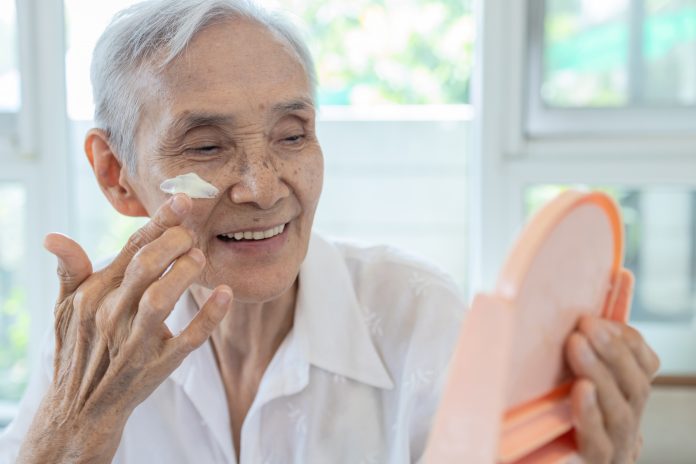Dr Deborah Lee, Dr Fox Online Pharmacy, tells us all about hyperpigmentation including the different types, the causes and the treatment options
I was upset the other day to notice a small, pale brown patch, underneath my right eye. I have fair skin, that tans with difficulty, and I must say these days – in my 50’s – I avoid the sun and haven’t sunbathed for years. I was quite dismayed. Yes, I concluded miserably, this was an age spot. It’s all about getting old. But it prompted me to find out more.
- What is hyperpigmentation of the skin?
- Why does it happen?
- Can it be prevented?
- What treatments are available?
What is hyperpigmentation of the skin?
The colour of your skin depends on the amount of the skin pigment, melanin. Melanin is a protein, produced by a specific type of skin cells called melanocytes.
Your skin is constantly in a state of flux. New skin cells are produced in the lower layers of the epidermis and gradually migrate upwards towards the skin surface, where they eventually die and are sloughed off.
Melanocytes are located in the deeper layers of the epidermis. In those with coloured skin, melanocytes produce more melanin than in white-skinned people. Melanin production is stimulated by exposure to UV radiation, and by inflammation.
In people with coloured skin, excess melanin helps protect the skin from sun damage. In fairer skinned people, melanin does not provide such good sun protection.
Hyperpigmentation is the name used to describe patches of skin that look darker. These can occur in many different skin types but are more common in people with coloured skin.
What the common types of hyperpigmentation?
The most common types of hyperpigmentation are –
- Age spots – These are small dark brown patches, sometimes called sunspots, which tend to develop on sun-exposed areas of skin such as the forehead, around the eyes, or elsewhere on the face or neck. They can also occur on the backs of the hands or the arms.
- Melasma – When larger patches of hyperpigmentation occur these are called melasma. In women, they are often linked to the use of hormonal contraception or HRT.
Hyperpigmentation can also occur as a result of pregnancy hormones when it is known as chloasma – often referred to as ‘the mask of pregnancy’.
- Post-inflammatory hyperpigmentation – This occurs when hyperpigmentation follows on from an area of inflammation on the skin, for example, following a flare up of acne lesions, or eczema. This results in a patch of discoloured skin. It can also develop after laser treatment or a chemical peel.
Why do some people develop areas of hyperpigmentation?
There can be many reasons for the development of hyperpigmentation.
- UV radiation – Exposure to sunlight triggers the production of melanin, hence you develop a suntan, which helps protect the skin from further sun damage. However, excessive sun exposure can exacerbate the situation and make any type of hyperpigmentation appear darker and more prominent.
- Ageing – As we age, although the number of melanocytes in the skin decrease, those that remain increase in size. The epidermis thins, so the skin looks thinner, is more fragile and more easily traumatised.
- Hormones – For reasons that are not fully understood, the combination of hormones – estrogen and progesterone – plus sunlight, increases the risk of hyperpigmentation. 10-25% of users of the combined contraceptive pill and up to 50% of pregnant women, develop hyperpigmentation.
- Post-inflammatory hyperpigmentation (PIH) – Anything that traumatises the skin and results in inflammation can trigger hyperpigmentation. This is because inflammation directly stimulates the production of melanin. Sometimes, it is more correctly termed ‘post-inflammatory erythema’ PIE (redness), for example, the reddish tinge to the skin that occurs in acne sufferers after picking and squeezing spots, even after the lesions have healed.
- Medical conditions – More generalised hyperpigmentation can occur as a result of certain diseases, although often the pigmentation is more pronounced in skin folds, skin creases, or pressure areas. In Addison’s Disease, cortisol levels are low, but levels of adrenocorticotropic releasing hormone (ACTH) are elevated. ACTH stimulates melanin production.
- Medicines – Many different types of medicines can result in hyperpigmentation. These include analgesics, antibiotics, anticoagulants, and antiretrovirals.
How to prevent hyperpigmentation
To prevent the onset of hyperpigmentation, always protect your skin from the sun. This means using a good quality sunscreen – at least SPF 30 or above, plus at least 4 out of 5 stars for UVA protection. The sunscreen should be applied liberally to all sun-exposed areas and reapplied every 2-hours, and after swimming. Remember, no sunscreen will give 100% protection – the only way to really avoid the sun is to stay out of it!
Wear a wide-brimmed sun hat. Sit in the shade. Avoid direct sunlight between 11 am and 3 pm when the sun is hottest.
Avoid the use of sunbeds.
What to do if you have hyperpigmentation?
Usually, this is a clinical diagnosis, and no tests are needed. However, it is important, if you’ve noticed a new pigmented mark or skin blemish, or any changes to pigmented lesions on your skin, to get this checked by your GP. The skin cancer, melanoma, is increasingly common, with around 16,000 melanomas are diagnosed every year in the UK. The incidence of melanoma is rising faster than any other cancers. For the ABCDE guide to checking your moles, click here.
Most cases of hyperpigmentation will not be due to melanoma, but to the more common condition – melasma. Once the diagnosis of melasma has been confirmed, treatment options can be discussed. You may be referred to see an NHS Consultant Dermatologist if this is indicated. Many of these treatments are only available on prescription.
Treatment options include –
- Hydroquinone – Hydroquinone inhibits the enzyme tyrosinase which is needed to make melanin. This is a skin cream, only available in the UK on prescription, which can be applied twice a day to the skin, for 6 months. Sometimes it is used at the same time as retinoids and topical steroids.
- Retinoids – These substances derive from vitamin A and are applied to the skin as a skin cream. They work to reduce hyperpigmentation by blocking the effects of tyrosinase, increasing epidermal skin turnover, and also facilitating the dispersal of pigment granules. Some can be purchased OTC and others require a prescription.
- Topical steroids – Steroid creams applied to the skin have a potent anti-inflammatory effect, and hence tend to reduce post-inflammatory hyperpigmentation. However, they should be used with great care on the face, as they can cause unwanted side effects, especially with long term use. Always take a dermatologist’s advice before doing this.
- Glycolic acid – This substance derives from sugar cane and is used as a chemical peel to remove the outer pigmented layers of skin. Although it can be effective, there is a risk that hyperpigmentation can occur after treatment.
Other chemical peels such as salicylic acid can also be effective. Chemical peels can have dangerous side effects, including cardiac arrhythmias, and facial scarring. Always seek the advice of an experienced Consultant Dermatologist before choosing to use a chemical peel.
- L-ascorbic acid (Vitamin C) – This also interferes with the enzyme tyrosinase. It also has the advantage of being a very potent antioxidant and anti-inflammatory agent. It is often combined in a skin cream along with hydroquinone preparations.
- N-acetyl glucosamine – This amino acid is a precursor to hyaluronic acid, and also has an inhibitory effect on tyrosinase. It is typically used in a skin cream along with niacinamide – a vitamin B3 derivative. It is generally well-tolerated and can produce good skin lightening effects.
- Laser treatment – Laser treatment can be used to treat hyperpigmentation but is usually reserved for when topical application has failed.
- Camouflage makeup – This is a practical option for those who wish to conceal areas of hyperpigmentation, for example, on the face, neck and hands.
- Tranexamic acid – Recently, there has been great interest in the possibility of using tranexamic acid (TA) to treat hyperpigmentation. TA is usually taken by mouth by women who have very heavy periods to help control the menstrual flow. However, TA is known to inhibit plasmin, which effectively shuts off the inflammatory cascade that triggers melanin production. Several small studies in humans have shown promising results in the treatment of hyperpigmentation from topical application to the skin. More research is needed.
Final thoughts
Looking after your skin is hard work. Unfortunately, we all tend to ignore our skin when we are young, at our peril. Once skin lesions have developed from excessive exposure to sunlight, they are difficult to treat. It’s a far better option to think ahead and stop them from developing it in the first place.
We all fear skin cancer, but even benign abnormalities of the skin such as hyperpigmentation can cause much distress, embarrassment, and affect our self-confidence and our social lives.
Don’t leave your skincare to chance. I am looking after my skin so much better now in my 50’s, whereas I wish I had done this 20-30 years ago.
For more information
- DermNet – NZ – What is melasma?
- British Association of Dermatology – Melasma
- The British Association of skin camouflage (BASC)
References











